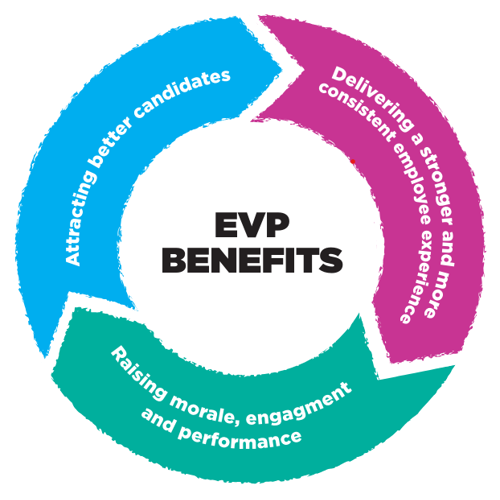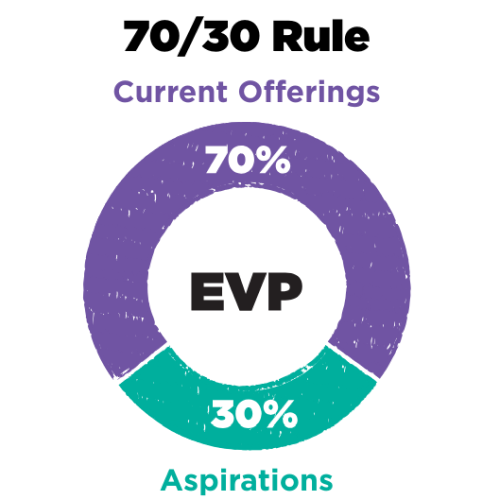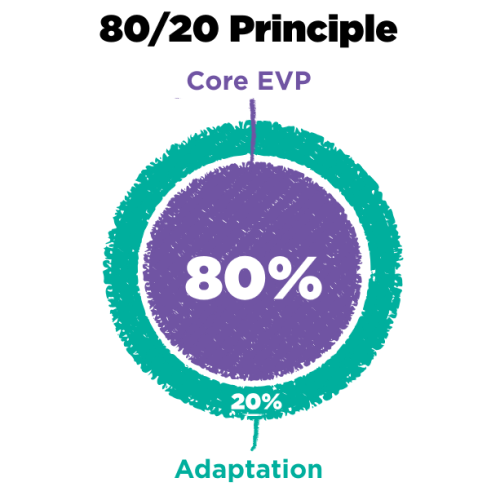Creating, refreshing or overhauling your Employee Value Proposition (EVP) is no simple undertaking. To do it successfully, you must take an approach that is proven to get results. We created this guide to help you craft a powerful EVP. Done correctly, an EVP will boost your organization’s ability to attract and retain the right high-performing talent.
Part 1: What is an EVP and why does it matter?
Part 2: 10-step guide to planning and implementing your EVP
Part 1: What is an EVP and why does it matter?
An EVP is the sum of experiences and rewards provided by an employer in exchange for the employee’s skills, knowledge and commitment. Essentially, it is the unspoken deal made between employer and employee based on a certain set of conditions. A strong EVP is clear, compelling and credible as well as aligned to the core brand and business strategy. It spells out what is unique and most valuable about working for you and what that means for employees.
Employee engagement cannot be switched on like a light-bulb. It is built over time through trust and consistently positive experiences. Your EVP is central to the framework needed to deliver and manage these positive experiences in order to create sustainable engagement and generate the corresponding value for your business.
Why does your EVP matter?
Your EVP is intrinsically linked to your talent brand (also referred to as employer brand), as it is the backbone that allows you to execute on that brand. Think of it this way: your EVP is the culture your organization is living, while your talent brand is the culture you are selling. In today’s always-online age of transparency, you cannot sell a vision of your company that does not match up with reality. It will quickly be discovered as false and do more harm to your brand than saying nothing at all.
Importance of talent brand
According to LinkedIn’s 4th Annual Global Recruiting Trends Survey, 75% of global Talent Acquisition leaders say talent brand has a significant impact on their ability to hire great talent. This is one reason EVPs should be of the utmost importance to business leaders and HR professionals.

Why your EVP is essential
Common sense dictates that to achieve optimal success, businesses must have an adequately informed, engaged and motivated workforce.
Your EVP is essential to attaining such a workforce. Here are a few reasons why:
- It is central to creating value for your business. Put simply, an engaged workforce will care more, contribute more and sell more than a disenchanted and demotivated workforce.
- It enables you to compete more effectively for talent. In a crowded and competitive marketplace, you need to stand for something in order to stand out and attract the right people. Your EVP is your ticket to differentiation.
- It informs your employer branding and attraction campaigns. Your EVP will drive the strategic and creative thinking that enables you to stand out. It is the nucleus of your messaging.
- It reduces time and money spent on recruitment. A clear EVP helps candidates make an informed decision about whether or not to apply for a role, which reduces time and money spent on poorly matched applicants and reduces attrition over the long run.
- It informs your HR policies and procedures. By providing a blueprint, you are clearly communicating how things are done in your organization, how people treat each other and how to create value for customers and stakeholders.
- It helps keep your business honest. Stay true to your EVP and your employees will amplify your positive messaging, reinforcing your reputation as a good employer. Let them down and the consequences can damage not only your employer brand, but also your consumer and corporate brand.
EVP principles
As you are developing your EVP, here are a few principles to abide by:
Keep it authentic and provable.
At least 70% of your EVP needs to accurately reflect your current offering, with the remaining 30% spelling out your aspirations for your future offer. This is known as the 70/30 Rule. For example, do not say, “We meet the work/life balance needs of our employees,” if you are not there yet. Instead, say, “We are developing a flexible working environment that will enable our employees to balance their commitments in and out of work.”

Make it relevant.
While the core attributes of your EVP will appeal across the board to the right people, different employee groups will have different needs and drivers, so you need to tailor your messaging to them. The deal you are making is personal, so always put yourself in the shoes of the candidate or employee group you are communicating with.
Be consistent.
EVPs evolve over time, but you need to be consistent about the core elements or you will dilute your messaging and risk confusing people. Fundamentals such as vision, values and culture are the glue that binds people together. When you need to take into account the nuances of different regions, geographies or divisions, aim to keep 80% of your core EVP, allowing for 20% adaptation to make the promise or offering relevant to that particular audience. We think of this as freedom within a framework, or the 80/20 Principle.

Differentiate.
To avoid sounding like your competitors, find out what your company does differently that you can leverage as a benefit. If you hold walking meetings rather than something more traditional, be sure to speak to that. Casual dress codes also make a difference. If you allow employees to work from home and your competitors will not allow it, make sure you stress that as a benefit.
Employee value proposition framework
Your EVP will consist of many components. The framework components are grouped into sets of extrinsic and intrinsic attributes. Both are underpinned by an organization’s purpose, vision and story. All of these elements influence an individual’s desire to join an organization, their levels of motivation and commitment, and ultimately, their productivity.
Extrinsic
Money, status & power
Rewards
- Are the salary and benefits competitive?
- What is given that others do not?
- Is there a genuine link to performance?
- What are the forma and informal recognition pathways?
Organization
- Is it financial stable?
- Is it a leader in the marketplace?
- Is it growing and does it have a plan for the future?
Brand reputation
- Is it a well-known and respected business?
- Does it have kudos?
- Are its products and services respected and/or loved?
Location/environment
- How desirable/convenient is the location?
- Would I feel proud to show it to my friends and associates?
- Would I enjoy spending time there?
Leadership/vision story
- Is there a clear and compelling story about where the business is heading?
- Is it backed up by a sound strategy and owned by strong leaders?
Intrinsic
Satisfaction, fulfillment & enjoyment
Work
- Is it interesting and stimulating?
- Would I be making a meaningful contribution/making a difference?
- Is it a good match for my skills and talents?
Opportunities
- Can they support my future ambitious?
- Will I get the coaching I need?
- How easy is it to be promoted/move within?
- Are there timescales for progression?
Culture/people
- Do the company values match mine?
- What's the management style?
- Will I be working with people I trust, respect and like?
- Will I feel valued, respected and empowered?
Lifestyle
- How flexible are working arrangements?
- What's the work/life balance?
- How progressive is the business? E.g. Do they enable new ways of working?
Leadership/vision story
- Is this a journey I want to be part of? (Where do I fit in and what's in it for me?)
Extrinsic + intrinsic = engaged, motivated & inspired
"The right deal"
It is worth remembering that when someone considers an employment opportunity, the extrinsic elements are at their most potent and are important bargaining chips. However, once that individual becomes an employee, the extrinsic factors start to wane in importance over the first six months and the intrinsic elements become the dominant factors in engagement, motivation and commitment.
PART 2: 10-step guide to planning and implementing your EVP
21st century talent expects a more fulfilling work experience than previous generations, which means you need a more sophisticated approach to designing your employee offering. Here is a 10-step guide to help you design, execute and implement your EVP successfully.
1. Build your business case.
Be clear about why you are embarking on your EVP journey. Know your key drivers for change and understand how they relate to the overall business strategy. Get a clear idea of how improving the employee experience would impact business performance. Determine the metrics you would use to measure success. Define the baseline. Research competitors and the wider market context. Be analytical in determining what this means for your business now and in the future. Understanding these points and communicating them clearly is how you build your business case.
- Gather data
- Assess competitive environment
- Set benchmark metrics
- Align to business strategy
2. Engage senior stakeholders.
You will need support from the top and across functions to develop your EVP model and strategy. Work with your senior stakeholders to help them identify what is in it for them. How will improvements in employee experience positively impact their agenda and function/division’s performance? Knowing the rewards will ensure commitment to the project and align stakeholders to a common cause.
- Consult
- Workshop
- Collaborate
- Capture drivers
- Refine the business case
- Secure commitment
3. Identify and segment your core employee and wider stakeholder audiences.
It is helpful to start with macro factors such as function or division, role and purpose, geographical placement and generational groups and then segment further by length of service and relationship with your business – candidate, new joiner, departing employee, etc. You will also need to consider diversity attributes such as gender and ethnicity as these may influence how your employer brand is perceived and how you message these audiences.
Finally, remember to include third party influencers such as recruiters, career advisors and possibly union or membership bodies in your mapping and research planning. Knowing your audiences also applies to understanding what skills, behaviors and attitudes constitute a great performer. You want to make sure these individuals are included and properly segmented in your research.
- Macro and micro segmentation
- High-performer and diversity attributes
- Third-party influencers
4. Engage your people and your candidates.
Canvas the views of your different audience groups to see what their current experience is like and how they would like things to be. Ask what elements they would most like to change or improve. Get an understanding of their reasons for joining, staying or leaving.
See which organizations they admire or aspire to be part of, and why. Ask what qualities and attributes they think it takes to be successful in their role. See what they would say to someone who was thinking of joining your business, and ask what the business needs to address the most. Also, ask how the organization comes across in the public domain.
- Quantitative surveys
- Qualitative interviews and focus groups
- Guaranteed confidentiality
5. Synthesize your insights.
Extract and analyze the core themes. What feedback is consistent across all groups? Look for nuances and for things that differentiate you from your competitors. Identify the pain points for your employees, as well as the power attributes you have as an employer that engage and motivate your people. Do the insights indicate that you have a good offer but you need to communicate it better or are there fundamental issues that need to be addressed?
This analytical look at your insights will help you understand what it will take to compete effectively and attract, retain and inspire the right people to create business value.
- Analyze core themes
- Highlight nuances
- Assess competitive positioning
- Identify implications
6. Build your EVP framework and outline strategy.
Using the framework for extrinsic and intrinsic attributes, build out your employee promise. You may want to do two versions: where you are now and where you want to be. You might also use a “red, yellow, green” coding system to highlight which attributes need changing and which are your “power attributes” that you can emphasize to increase your attractiveness in the talent marketplace and increase employee engagement. Remember to capture the “deal” part of the EVP too, meaning what you can expect to get back from employees in exchange for what you offer
- Visualize and articulate
- Highlight pain points and power attributes
- Define aspirations
7. Validate your EVP framework and outline strategy.
Use focus groups and workshopping sessions to test your core findings and to begin identifying the different work streams that will be required to make any necessary changes going forward. Refresh stakeholders’ enthusiasm and commitment by reminding them of your business case and what is in it for them. Keep everyone’s eyes on the prize.
- Focus groups
- Workshops
- Refresh commitment
- Align thinking
- Develop strategy
8. Design messaging frameworks.
Now that your core findings have been validated and you have agreed on your aspirations for your EVP, you can start to decide how you will communicate your offer to your different audiences. Remember to apply the 70/30 Rule and 80/20 Principle and – critically – keep the language clear, simple and relevant. You are making a promise to individuals, so use language they will understand and avoid corporate buzzwords.
- Core promise
- Tailored to different audiences
- Credible commitment
- Clear and simple language
9. Develop your internal and external communication strategies.
You know what your employee promise stands for. Now you need to make sure it stands out. Identify ways in which you can bring your messaging to life through stories, case studies, interviews, etc., and how these can be expressed through engaging media such as videos, infographics and articles. Then plan how you will distribute this content to your different audiences, whether it is at events, online, through print or other means. Aim to create a 12-month calendar of communication in advance and decide what metrics you will use to assess its impact and refine future iterations.
- Compelling content
- Clear channel strategies
- Communication owners
- Ongoing measurement
10. Launch!
Use your pre-launch phase to engage and brief leaders, managers and work stream leaders on what is coming and what is required of them. Set your dates for internal launch and for the refresh of your external messaging platforms. Involve your people in the process, so they can be active participants in the development journey and in making the EVP a reality for all concerned.
- Brand ambassadors
- Media coverage
- Leadership endorsement
- Joint journey-setting
Final thoughts
Building a powerful EVP is critical to achieving great employee engagement and reaping the rewards of a committed and motivated workforce. It needs to be a living asset – one that informs your people agenda, policies and processes. As you investigate to inform your messaging, there may be elements that you are not proud of. Those are the elements you need to be working to improve. Being candid about what is working and what is not is an opportunity to demonstrate integrity and engage your people in the journey of improvement.






